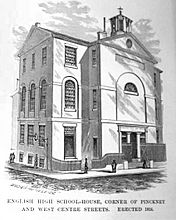Phillips School facts for kids
Quick facts for kids Phillips School |
|
|---|---|
 |
|
| General information | |
| Location | Beacon Hill |
| Address | Private Residence: Pinckney and Anderson |
| Town or city | Boston |
| Country | United States |
| Coordinates | 42°21′32″N 71°04′04″W / 42.358974°N 71.067835°W |
The Phillips School was an important school building in Beacon Hill, Boston, Massachusetts. It was built in 1824 and first served as a school for white children. Later, it became one of the first schools in Boston to welcome students of all races. Today, the building is a private home. It is also a stop on the Black Heritage Trail, which teaches about African American history in Boston.
Contents
School History
The English High School
The building that became the Phillips School was first home to the English High School. It was built between 1823 and 1825. Its design was typical of other schools built in Boston during the 1800s.
Phillips Grammar School
In 1844, the building became a grammar school. It was named the Phillips Grammar School. The school was named after John Phillips, who was the first mayor of Boston. His son, Wendell Phillips, later became a famous abolitionist, someone who worked to end slavery.
The Phillips School taught children from the local area. Many of these students came from wealthy families. At that time, there was another public school called the Abiel Smith School. This school was specifically for African American children. The Phillips School was known as one of the best schools in Boston.
African American people in Boston worked very hard to get equal education. For example, in 1847, a man named Benjamin tried to enroll his daughter in a white school near his home, and then at the Phillips School. He was not successful. However, in 1855, a new law in Massachusetts made schools integrate. This meant that schools could no longer be separated by race. The Phillips School then became one of the first integrated schools in Boston.
Wendell Phillips School
In 1863, the Phillips School moved to a new building on Phillips Street. This street used to be called Southac Street. The school was renamed the Wendell Phillips School. This new name honored Wendell Phillips, the famous abolitionist. He was the son of the original John Phillips.
In the early 1870s, an important teacher named Elizabeth Smith began working at the Phillips School. She was the daughter of another abolitionist, John J. Smith. Elizabeth Smith was likely the first African American teacher in an integrated public school in Boston.
Black Heritage Trail Site
The former Phillips School building is an important historical site. It is part of the Boston African American National Historic Site. You can find it on the Black Heritage Trail in Beacon Hill. This trail helps people learn about the history of African Americans in Boston.
Gallery




